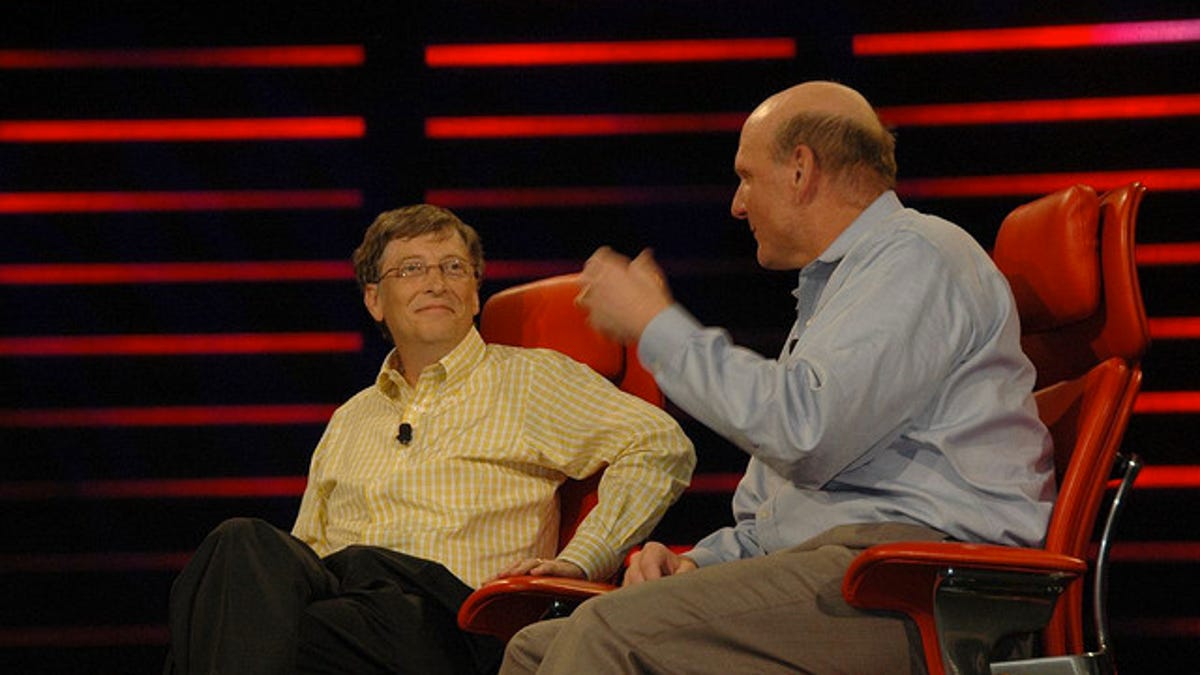Bill Gates, Steve Ballmer and the parting of the ways
Ballmer gets the blame for Microsoft's recent lackluster stock performance and assorted product misses, and so should Bill Gates and rest of the company's board of directors.

It was one of the longest-running duos in the history of the technology industry. Bill Gates and Steve Ballmer, Harvard classmates and later business partners running what once was the most dominant company of its era.
Now it's over.
On Friday, Ballmer issued a surprise announcement stating his intention to step down sometime over the next 12 months. Much of the subsequent commentary has focused on shortcomings in Ballmer's stewardship. But a close review of the record suggests a more complicated narrative, one in which it's clear that both Ballmer and Gates shared equally in the company's successes as well as its failures.
"We're both pretty good about being two people with one huge job. Who has what title isn't a phenomenal element of that," Gates told Forbes in October 1999.
That was a fair summation of their business arrangement, even after Ballmer replaced Bill Gates as Microsoft's chief executive officer in January 2000. That was an especially delicate transition coming as it did around the time that US District Court Judge Thomas Penfield Jackson had found the company to be a predatory monopolist. Six months later, the court ordered Microsoft broken into two parts: one would be an operating system provider, the other a software company. A year and a half later, Microsoft reached a deal with the Department of Justice that let it remain a single company. In return, Microsoft had to keep on its best behavior and share some APIs with developers.
But even though he had stepped out of the limelight, Gates remained deeply involved in Microsoft's technology direction after handing Ballmer the CEO title. He set himself up as the company's chief software architect and continued to lead the "Longhorn" project, which eventually became Vista. The goal for Longhorn was worthy -- remaking Windows, Windows Server, MSN, Microsoft Office, .NET, and other code for the Internet age. But the results failed to meet expectations after Vista finally began shipping in January 2006.
Ballmer acknowledged as much during an exclusive interview with ZDNet's Mary Jo Foley, implicating Gates in what he called his greatest regret in 33 years at Microsoft. "I would say probably the thing I regret most is the, what shall I call it, the loopedy-loo that we did that was sort of Longhorn to Vista," he said. "I would say that's probably the thing I regret most." Gates probably has a similar view of the flawed five-year project to remake Windows. Both are hoping that the latest effort to remake Windows in the wake of the PC sales slowdown is more of a success.
By then, Gates had begun to tire of the grind. Six months after the release of Vista, Gates announced plans to give up his day-to-day duties. He would advise on key projects for next two years, and then devote himself more full time to solving global health issues at his Bill and Melinda Gates Foundation. Lotus Notes creator Ray Ozzie took over as Microsoft's top software architect.
But Gates still remained as chairman. Indeed, for the past 13 years, Gates and Ballmer have continued to work together. Let's not forget that Ballmer reported to a board of directors that was led, if not dominated, by his longtime friend.
During the course of Ballmer's tenure, Microsoft's revenue tripled and profits doubled. But the company's stock price failed to reflect those gains and became a source of investor grumbling. In part, that reflected Microsoft's difficulty adapting to a shifting technology landscape where smartphones and tablets were replacing desktops and laptops and search was revolutionizing the Internet advertising business.
While Ballmer was wrestling with creating a new Windows platform that turned into Vista, and eventually Windows 8, Apple and Google were leaving Microsoft behind in the move to mobile. The company's stock price never recovered. Microsoft's market value decreased from $604 billion when Ballmer became CEO to $269 billion just prior to his retirement announcement.
Nonetheless, Gates as Microsoft chairman stuck with his friend. He was reluctant to make a change even as pressure on Ballmer increased. Former board member and Netflix CEO Reed Hastings was reportedly one of those urging Microsoft to dump Ballmer as CEO. Hastings left Microsoft's board in October 2012 after serving five years.
Perhaps they were guilty of self-delusion, but both Gates and Ballmer are strategic thinkers who got where they are by sticking with long-term visions. The rest of the board apparently bought into that vision, figuring that Microsoft would eventually get it right.
Unfortunately for Ballmer, the promises became part of a repetitive storyline. After high-profile failures with Microsoft Phone and the Zune digital music player, Microsoft last year tried to offset declining PC sales by designing and manufacturing its own Surface tablet computers that run Windows. If Apple could do it, why not Microsoft? On paper that sounded reasonable but Microsoft stumbled quickly. In the company's fourth-quarter Microsoft missed expectations badly. More embarrassing, it took a $900 million write-down of unsold Surface RTs.
Ballmer obviously gets the blame for the company's poor financial performance and assorted product misses, but it's also clear that Gates and the rest of Microsoft's board were involved in every major strategy decision.
The last chapter in their shared legacy will need to wait a while. Earlier this year, Ballmer restructured the company around devices and services while getting rid of product fiefdoms. It was an ambitious and big move designed to institute a more collaborative environment among leadership team, most who came up through the ranks. Though Ballmer won't be around to see how it turns out, Gates will.

